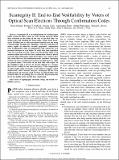| dc.contributor.author | Chaum, David | |
| dc.contributor.author | Carback, Richard T. | |
| dc.contributor.author | Clark, Jeremy | |
| dc.contributor.author | Essex, Aleksander | |
| dc.contributor.author | Popoveniuc, Stefan | |
| dc.contributor.author | Rivest, Ronald L. | |
| dc.contributor.author | Ryan, Peter Y. A. | |
| dc.contributor.author | Shen, Emily (Emily Huei-Yi) | |
| dc.contributor.author | Sherman, Alan T. | |
| dc.contributor.author | Vora, Poorvi L. | |
| dc.date.accessioned | 2010-03-12T18:14:35Z | |
| dc.date.available | 2010-03-12T18:14:35Z | |
| dc.date.issued | 2009-11 | |
| dc.date.submitted | 2009-10 | |
| dc.identifier.issn | 1556-6013 | |
| dc.identifier.other | INSPEC Accession Number: 10978370 | |
| dc.identifier.uri | http://hdl.handle.net/1721.1/52547 | |
| dc.description.abstract | Scantegrity II is an enhancement for existing paper ballot systems. It allows voters to verify election integrity - from their selections on the ballot all the way to the final tally - by noting codes and checking for them online. Voters mark Scantegrity II ballots just as with conventional optical scan, but using a special ballot marking pen. Marking a selection with this pen makes legible an otherwise invisible preprinted confirmation code. Confirmation codes are independent and random for each potential selection on each ballot. To verify that their individual votes are recorded correctly, voters can look up their ballot serial numbers online and verify that their confirmation codes are posted correctly. The confirmation codes do not allow voters to prove how they voted. However, the confirmation codes constitute convincing evidence of error or malfeasance in the event that incorrect codes are posted online. Correctness of the final tally with respect to the published codes is proven by election officials in a manner that can be verified by any interested party. Thus, compromise of either ballot chain of custody or the software systems cannot undetectably affect election integrity. Scantegrity II has been implemented and tested in small elections in which ballots were scanned either at the polling place or centrally. Preparations for its use in a public sector election have commenced. | en |
| dc.language.iso | en_US | |
| dc.publisher | Institute of Electrical and Electronics Engineers | en |
| dc.relation.isversionof | http://dx.doi.org/10.1109/TIFS.2009.2034919 | en |
| dc.rights | Article is made available in accordance with the publisher's policy and may be subject to US copyright law. Please refer to the publisher's site for terms of use. | en |
| dc.source | IEEE | en |
| dc.subject | privacy | en |
| dc.subject | end-to-end verifiability | en |
| dc.subject | electronic voting | en |
| dc.subject | cryptography | en |
| dc.title | Scantegrity II: End-to-End Verifiability by Voters of Optical Scan Elections Through Confirmation Codes | en |
| dc.type | Article | en |
| dc.identifier.citation | Chaum, D. et al. “Scantegrity II: End-to-End Verifiability by Voters of Optical Scan Elections Through Confirmation Codes.” Information Forensics and Security, IEEE Transactions on 4.4 (2009): 611-627. © 2009 Institute of Electrical and Electronics Engineers | en |
| dc.contributor.department | Massachusetts Institute of Technology. Department of Electrical Engineering and Computer Science | en_US |
| dc.contributor.approver | Rivest, Ronald L. | |
| dc.contributor.mitauthor | Rivest, Ronald L. | |
| dc.contributor.mitauthor | Shen, Emily Huei-Yi | |
| dc.relation.journal | IEEE Transactions on Information Forensics and Security | en |
| dc.eprint.version | Final published version | en |
| dc.type.uri | http://purl.org/eprint/type/JournalArticle | en |
| eprint.status | http://purl.org/eprint/status/PeerReviewed | en |
| dspace.orderedauthors | Chaum, D.; Carback, R.T.; Clark, J.; Essex, A.; Popoveniuc, S.; Rivest, R.L.; Ryan, P.; Shen, E.; Sherman, A.T.; Vora, P.L. | en |
| dc.identifier.orcid | https://orcid.org/0000-0002-7105-3690 | |
| dspace.mitauthor.error | true | |
| mit.license | PUBLISHER_POLICY | en |
| mit.metadata.status | Complete | |
